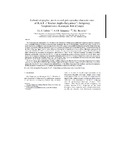Please use this identifier to cite or link to this item:
http://hdl.handle.net/10311/391Full metadata record
| DC Field | Value | Language |
|---|---|---|
| dc.contributor.author | Cailteux, J.L.H. | - |
| dc.contributor.author | Kampunzu, A.B.H. | - |
| dc.contributor.author | Batumike, M.J. | - |
| dc.date.accessioned | 2009-10-15T14:00:40Z | - |
| dc.date.available | 2009-10-15T14:00:40Z | - |
| dc.date.issued | 2005 | - |
| dc.identifier.citation | Cailteux, J.L.H. et al (2005) Lithostratigraphic position and petrographic characteristics of R.A.T. (‘‘Roches Argilo-Talqueuses’’) Subgroup, Neoproterozoic Katangan Belt (Congo), Journal of African Earth Sciences, Vol. 42, pp. 82–94 | en_US |
| dc.identifier.issn | 1464-343X | - |
| dc.identifier.uri | http://hdl.handle.net/10311/391 | - |
| dc.description.abstract | The Neoproterozoic Katangan R.A.T. ("Roches Argilo-Talqueuses") Subgroup is a sedimentary sequence composed of red massive to irregularly bedded terrigenous-dolomitic rocks occurring at the base of the Katangan succession in Congo. Red R.A.T. is rarely exposed in a continuous section because it was affected by a major layer-parallel de´collement during the Lufilian thrusting. However, in a number of thrust sheets, Red R.A.T. is in conformable sedimentary contact with Grey R.A.T which forms the base of the Mines Subgroup. Apart from the colour difference reflecting distinct depositional redox conditions, lithological, petrographical and geochemical features of Red and Grey R.A.T. are similar. A continuous sedimentary transition between these two lithological units is shown by the occurrence of variegated to yellowish R.A.T. The D. Strat. "Dolomies Stratifie´es" formation of the Mines Subgroup conformably overlies the Grey R.A.T. In addition, a transitional gradation between Grey R.A.T. and D. Strat. occurs in most Cu–Co mines in Katanga and is marked by interbedding of Grey R.A.T.-type and D. Strat.-type layers or by a progressive petrographic and lithologic transition from R.A.T. to D. Strat. Thus, there is an unquestionable sedimentary transition between Grey R.A.T. and D. Strat. and between Grey R.A.T. and Red R.A.T. The R.A.T. Subgroup stratigraphically underlies the Mines Subgroup and therefore R.A.T. cannot be comprised of syn-orogenic sediments deposited upon the Kundelungu (formerly ‘‘Upper Kundelungu’’) Group as suggested by Wendorff (2000). As a consequence, the Grey R.A.T. Cu–Co mineralisation definitely is part of the Mines Subgroup Lower Orebody, and does not represent a distinct generation of stratiform Cu–Co sulphide mineralisation younger than the Roan orebodies. | en_US |
| dc.language.iso | en | en_US |
| dc.publisher | Elsevier www.elsevier.com/locate/jafrearsci | en_US |
| dc.subject | Lithostratigraphy | en_US |
| dc.subject | Petrography | en_US |
| dc.subject | R.A.T.—Mines Subgroup | en_US |
| dc.subject | Sedimentary rocks | en_US |
| dc.subject | Copperbelt | en_US |
| dc.subject | Congo | en_US |
| dc.title | Lithostratigraphic position and petrographic characteristics of R.A.T. (‘‘Roches Argilo-Talqueuses’’) Subgroup, Neoproterozoic Katangan Belt (Congo) | en_US |
| dc.type | Published Article | en_US |
| Appears in Collections: | Research articles (Dept of Geology) | |
Files in This Item:
| File | Description | Size | Format | |
|---|---|---|---|---|
| Kampunzu2005Lithostratigraphic.pdf | 1.88 MB | Adobe PDF |  View/Open |
Items in DSpace are protected by copyright, with all rights reserved, unless otherwise indicated.
